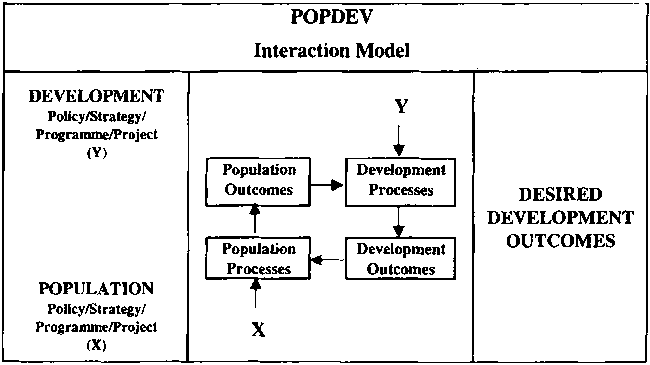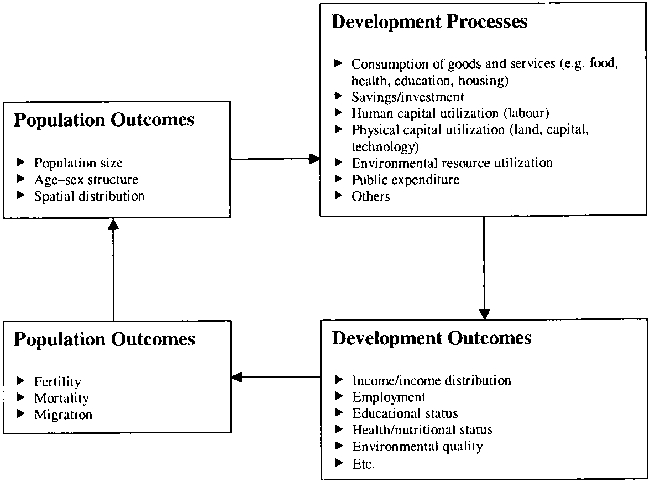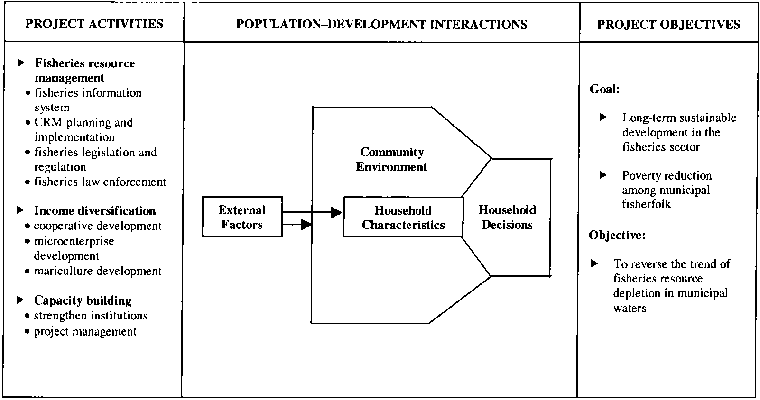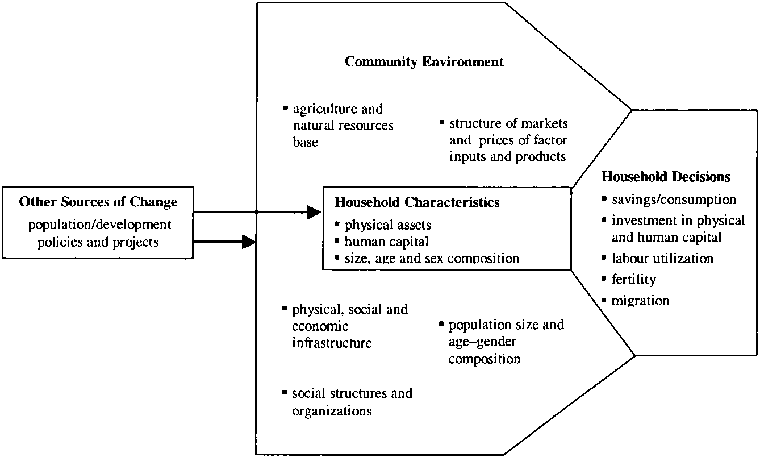This chapter highlights the salient features of population-development relationships and provides the contextual background for the succeeding discussion on identifying and monitoring socio-economic and demographic characteristics of fishing communities.
The familiar argument that rapid population growth has an impact on socio-economic development and vice-versa can be better appreciated through the population-development (POPDEV) framework.[5] This framework underscores the interrelationships between and among population and development variables (i.e. demographic processes affecting socio-economic outcomes and socio-economic processes affecting demographic outcomes).
The general framework presented in Figure 1 draws attention to the interaction between population factors and development factors in terms of processes and outcomes. Because of such interactions, one can start at any point to analyse population-development relationships: Population processes lead to development outcomes and vice-versa; development processes eventually affect population outcomes and vice-versa. The implication of this framework is that any policy formulated to achieve desired development objectives - be it a development or population policy - will impact on both population and development processes.
To illustrate, in Figure 2 the demographic processes of fertility, mortality and migration lead to the outcomes of population size, age-sex structure and the spatial distribution of the population. These demographic outcomes impact on development processes such as the consumption of goods and services, savings and investment behaviour, the utilization of human, physical and natural resources, etc. These development processes, in turn, lead to development outcomes, which can be expressed in terms of income or its distribution, levels of employment, educational status, health and nutritional status, environmental quality and which might be affected by extensive and overexploitation of natural resources. These socio-economic outcomes, in turn, also alter the population processes of fertility, mortality and migration - the starting point of this illustration.
At the micro/project level, development policies and strategies are translated more concretely into programmes and projects that directly affect specific populations.
A framework for population-development integration at the micro level is shown in Figure 3. A specific project on fishery resource management currently being implemented in the Philippines is used as an illustrative example. The target population groups are the municipal fishing communities where a set of project interventions and activities are being introduced with the objective of reversing resource depletion in municipal waters.
FIGURE 1
Population-development framework: A
macro perspective

Source: Training module on integrated population and development planning (NEDA, 1993)
FIGURE 2
Population-development
interrelationships: A general overview

Source: Training module on integrated population and development planning (NEDA, 1993)
The attainment of the project objective and goals will depend to a large extent on the population-development interactions at the community and household levels. Figure 4 expands the framework in Figure 3 to show how specific interactions between demographic and socioeconomic factors at the household level can be analysed.
There are three major elements in the micro/project framework:
(a) the household decision-making model
The household decision-making model outlines the different decisions a household makes, and how such decisions are shaped by and dependent on household characteristics, the community environment and other external factors.
(b) the community environment
The community environment includes the physical, social and economic factors that are usually outside the household’s control, but which affect the household as factors and objects of production. An important element is the social structure and organization of the community, i.e. whether members of the community work together for the common good or for themselves alone. This is especially critical in community-based coastal resource management programmes, as the success of such programmes is premised on community participation, responsibility and accountability.
(c) other sources of change
Other sources of change are external factors that indirectly affect the household by directly affecting other factors in the community.
FIGURE 3
Framework for population-development
integration at the micro level: Fisheries Resource Management
Project

Source: The framework is adapted from the Training module on integrated population and development planning (NEDA, 1993); contents of Project Activities and Project Objectives were taken from Memorandum of understanding between the Department of Agriculture and the Bank Loan Appraisal Mission regarding the Fisheries Resource Management Project (ADB, 1997).
FIGURE 4
Framework for analysing
population-development interrelationships at the household level

Source: Training module on integrated population and development planning (NEDA, 1993)
As a planning and management tool, the POPDEV framework provides the planner with a better understanding of how household decision-making is influenced by the interaction of factors at the household and the community levels, as well as by other external factors. Such appreciation of the interactions and interrelationships among the variables enables the planner to analyse projects intended to benefit households or the community in their proper context.
|
[5] Unless otherwise stated,
this discussion on the population-development framework is based on the Training
Module on Integrated Population and Development Planning (NEDA, 1993). This
framework has been institutionalised at national and local levels through its
use by several population-development projects of NEDA such as the Population
and Development Planning and Research Project (1980-1989), the Integrated
Population and Development Planning Project and, more recently, the POPDEV
Planning at the Local Level Project. |